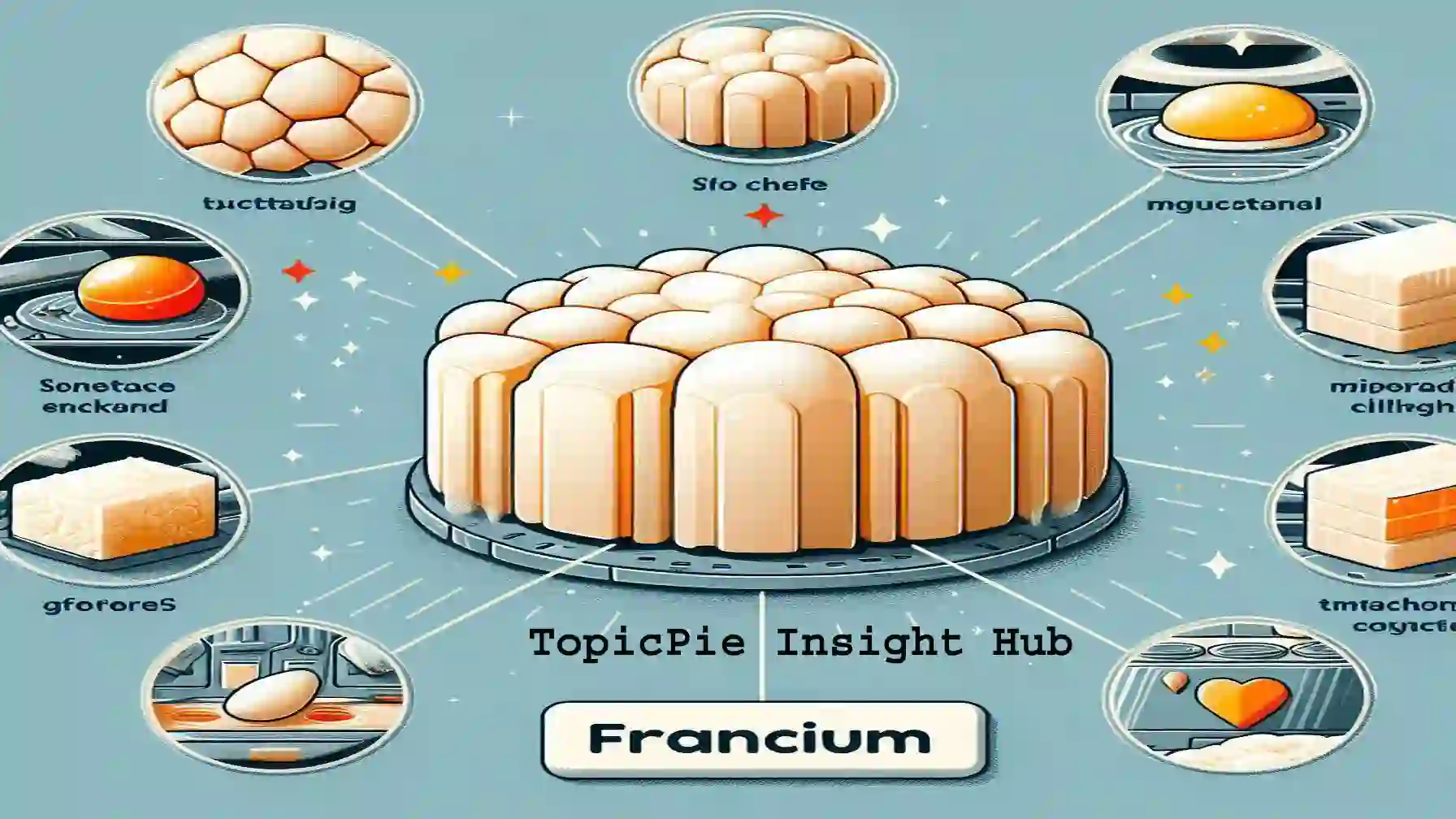Francium, the most electropositive element on the periodic table, exists in a shadowy realm. Unlike the familiar elements that build our world, francium is a fleeting phantom, only achievable in a laboratory. With a half-life of a mere 22 minutes, this elusive element constantly decays into other substances. Yet, despite its scarcity, francium holds immense potential for modern science.
This blog post will embark on a journey to unveil the secrets of francium. We’ll delve into its fascinating history and discovery, explore its unique physical and chemical properties, and examine the reasons why francium remains a subject of curiosity among scientists worldwide. We’ll explore the potential uses of francium, the challenges associated with handling this radioactive element, and the exciting possibilities it holds for the future of science. Join us as we unlock the secrets of francium and discover the remarkable potential it offers!
Francium: History and Discovery
Back in 1939, French chemist Marguerite Perey made a groundbreaking discovery while working at the Curie Institute in Paris. She detected the element Francium through analyzing actinium’s decay products, marking a significant moment in scientific history.
Named after France, Francium is an incredibly rare and highly radioactive alkali metal with atomic number 87 on the periodic table. Its fleeting existence poses challenges for scientists to study its properties comprehensively.
Due to its extreme rarity and radioactivity, Franciums has limited practical applications compared to other elements. However, its unique characteristics make it valuable for research purposes in nuclear physics and atomic structure studies.
Despite being challenging to work with due to its short half-life and radioactivity, Francium continues to intrigue scientists worldwide as they uncover more about this elusive element’s properties and potential applications in modern science.
Occurrence:
Francium is one of the rarest elements on Earth, with an estimated total of only 30 grams naturally present in the Earth’s crust at any given time. This highly radioactive metal is primarily found in trace amounts within uranium and thorium ores. Due to its unstable nature, francium readily decays and doesn’t exist in significant quantities.
Scientists can also produce franciums artificially through nuclear reactions. A common method involves bombarding thorium with protons, which results in the creation of minute amounts of a specific francium isotope, francium-223. However, this isotope also has a short half-life of approximately 22 minutes, rapidly decaying into other elements.
Also Read: Indian Stock Market: A Comprehensive Guide to Navigating NSE and BSE for Beginners
Given its scarcity in nature and high reactivity, studying franciums poses various challenges for scientists. Its short half-life further complicates efforts to isolate substantial quantities for research purposes. Despite these challenges, francium’s unique properties make it a fascinating subject for scientific exploration and potential applications.
Physical Characteristics:
Francium’s physical characteristics, as an alkali metal, include being soft and easily deformable with a shiny appearance when freshly cut. However, its high reactivity makes it tarnish quickly in air.
The most notable physical characteristic of francium is its extreme radioactivity. With a half-life of only about 22 minutes, it’s challenging to work with in large quantities and limits practical applications.
Despite its scarcity, scientists continue to explore francium’s unique physical properties. One such intriguing property is its predicted low melting point (around 27°C) which is surprisingly low for a metal. Studying these characteristics offers valuable insights into the behavior of elements at extreme conditions and has potential for future applications in various scientific fields like nuclear physics and chemistry.
Chemical Characteristics:
Francium, the rare and highly reactive alkali metal, exhibits fascinating chemical characteristics that intrigue scientists worldwide. Being a member of Group 1 in the periodic table, francium shares similarities with other alkali metals like cesium and rubidium. However, due to its extreme rarity and radioactivity, studying its chemical properties poses unique challenges.
One notable trait of francium is its tendency to react vigorously with water and oxygen, forming compounds such as franciums hydroxide. Its high reactivity stems from having just one valence electron in its outer shell, making it eager to form bonds with other elements.
Despite being challenging to work with due to its scarcity and short half-life isotopes, researchers are continuously exploring potential applications for franciums in various fields of science. Its chemical behavior provides valuable insights into fundamental principles governing atomic interactions at the most basic level.
As advancements in technology continue to push boundaries in scientific research, understanding the chemical characteristics of francium opens up new possibilities for innovative discoveries and breakthroughs across diverse disciplines.
Significance and Uses:
Francium, despite its scarcity and radioactivity, holds significant potential in various scientific applications. Due to its highly reactive nature, francium is utilized in research related to atomic structure and fundamental particles. Its unique properties make it valuable for studying radioactive decay processes and understanding the behavior of heavy elements.
In the field of nuclear physics, francium plays a crucial role in experiments that investigate symmetries in fundamental interactions. Scientists use it as a probe to explore subtle differences between matter and antimatter at an atomic level. This research contributes to our understanding of the universe’s composition and fundamental forces.
Moreover, francium isotopes have been theoretically proposed for application in medical imaging techniques like Positron Emission Tomography (PET). The short half-life of some Francium isotopes makes them potentially suitable for tracking chemical processes within living organisms on a molecular level. However, significant challenges associated with handling this rare element need to be addressed before this becomes a practical application.
Despite these challenges, ongoing research continues to unveil new uses and significance for francium across various scientific disciplines.
Health Hazards:
Francium’s extreme radioactivity poses significant health hazards. Exposure to its ionizing radiation can damage cells and DNA, potentially leading to various health issues such as cancer and genetic mutations. However, due to its extreme rarity in nature, large-scale exposure incidents are highly unlikely.
The primary health risks associated with francium are faced by researchers who handle this element in laboratory settings. Given its short half-life, handling francium requires extreme caution and specialized equipment to minimize radiation exposure. Researchers must strictly adhere to safety protocols and guidelines set forth by regulatory bodies to mitigate any potential health hazards.
Isotopes of Francium:
Francium has over 37 known isotopes, with francium-223 (Fr-223) being the most stable. Unfortunately, due to their high radioactivity and short half-lives, many of these isotopes are extremely rare and difficult to study in depth. Francium-221 (Fr-221) is another notable isotope that emits a significant amount of gamma radiation.
These isotopes play a crucial role in nuclear physics research, providing valuable insights into fundamental particles’ behavior at the atomic level. Researchers use them to investigate various phenomena like nuclear reactions and decay processes.
Despite their limited availability, scientists continue to explore the unique properties of francium isotopes for potential applications in fields such as medical imaging and cancer treatment. The unstable nature of these isotopes presents challenges but also opens up opportunities for innovative scientific discoveries.
Applications:
Francium, despite its scarcity on Earth, has potential applications in various scientific fields. Due to its highly reactive nature, francium can be used in studies related to atomic structure and fundamental physics. Its radioactive properties make it valuable for research on nuclear reactions and the behavior of unstable elements.
In the medical field, francium isotopes are theoretically proposed for use in cancer treatment through targeted alpha therapy. This approach holds promise for more effective and precise cancer treatments with minimal damage to surrounding healthy tissue. However, significant challenges associated with handling this rare element need to be addressed before this becomes a practical application.
Furthermore, due to its ability to displace other alkali metals from compounds, francium may have applications in organic synthesis and chemical reactions. Research is ongoing to explore its potential use as a catalyst in certain chemical processes.
While still under exploration and development, the unique properties of francium offer exciting possibilities for advancements in science and technology across various disciplines.
Production:
The production of francium is a challenging task due to its extreme rarity and short half-life. Francium is not found naturally in significant quantities on Earth, requiring it to be artificially produced in laboratories.
The most common method for producing franciums involves bombarding thorium with protons in nuclear reactions. These reactions result in the formation of minute amounts of franciums isotopes. Another approach includes using accelerators to induce fusion reactions that lead to the creation of francium atoms.
Due to its high reactivity and radioactivity, handling francium during production requires specialized equipment and strict safety protocols. Scientists continue to explore innovative techniques for efficiently producing and isolating usable quantities of this elusive element for further research and potential applications in various scientific fields.
By specifying the common method and emphasizing the challenge of producing usable quantities, this revision provides a more nuanced view of Francium production.

Exploring Francium: Erroneous and Incomplete Discoveries
Erroneous and incomplete discoveries surrounding francium have intrigued scientists for decades. Due to its extreme rarity and radioactivity, research on this element has faced challenges. In the past, there were claims of discovering francium in certain minerals or ores, only to later realize it was a misidentification due to its fleeting nature.
Incomplete findings have also been reported where researchers thought they had isolated pure franciums but could not confirm its presence conclusively due to its highly reactive properties. These erroneous discoveries and incomplete experiments highlight the difficulties in studying an element as elusive as francium.
Despite these setbacks, ongoing advancements in technology and scientific methods continue to shed light on the true characteristics of franciums. Researchers remain determined to unravel the mysteries surrounding this intriguing element for potential future applications in various scientific fields.
Francium Compounds and Reactions:
Compounds of francium are rare due to its extreme rarity and radioactivity. However, some studies suggest that francium could potentially form ionic compounds similar to those of other alkali metals, such as franciums chloride (FrCl).
When it comes to reactions involving francium, the element is highly reactive due to its position on the periodic table (Group 1). Francium readily reacts with water vapor in the air, producing hydrogen gas and a white cloud of hydrogen fluoride (HF). In laboratory settings, researchers have managed to observe some limited reactions of franciums with other elements under controlled conditions, such as its reaction with halogens to form francium halides. These experiments provide valuable insights into the reactivity and properties of this elusive element.
Despite the challenges posed by its short half-life and scarcity, ongoing research aims to further explore the chemical behavior of franciums in various compounds and reactions. This exploration could unlock new possibilities for utilizing this intriguing element in future scientific endeavors.
By mentioning a reaction with halogens, this revision provides a broader picture of Francium’s reactivity beyond just water vapor.
You may also like to read: How Offshore Wind Power is Revolutionizing Renewable Energy?
Potential Future Applications in Science:
With ongoing advancements in science and technology, the potential future applications of francium are vast and promising. Researchers are exploring its use in areas such as nuclear medicine, where it could play a crucial role in targeted alpha therapy for cancer treatment. Additionally, due to its highly reactive nature and ability to form unique compounds, franciium holds potential in organic chemistry studies.
Furthermore, With the development of more efficient methods for producing and isolating francium isotopes, scientists can delve deeper. This could lead to breakthroughs in fundamental physics research. For example, testing theories related to the standard model of particle physics.
As our understanding of this rare element continues to grow, so too will its potential applications across various scientific disciplines. The future of francium is promising. Researchers unlock new possibilities, harnessing its unique properties to drive innovation in science. Discovery in modern science continues to flourish, driven by the potential of francium’s unique properties.








